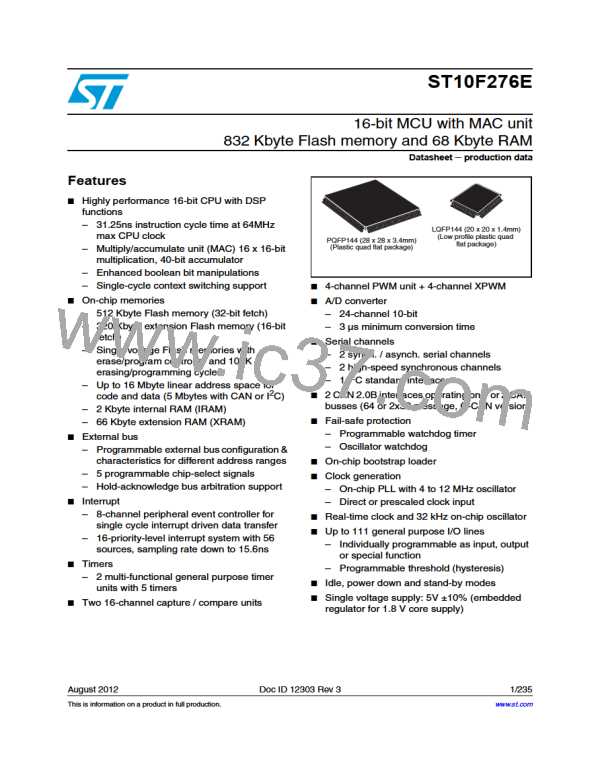Introduction
ST10F276E
●
Embedded memory size has been significantly increased (both Flash and RAM).
●
PLL multiplication factors have been adapted to new frequency range.
A/D Converter is not fully compatible versus ST10F269 (timing and programming
model). Formula for the conversion time is still valid, while the sampling phase
programming model is different.
Besides, additional 8 channels are available on P1L pins as alternate function: the
accuracy reachable with these extra channels is reduced with respect to the standard
Port5 channels.
●
External Memory bus potential limitations on maximum speed and maximum
capacitance load could be introduced (under evaluation): ST10F276E will probably not
be able to address an external memory at 64MHz with 0 wait states (under evaluation).
●
●
●
XPERCON register bit mapping modified according to new peripherals implementation
(not fully compatible with ST10F269).
Bondout chip for emulation (ST10R201) cannot achieve more than 50MHz at room
temperature (so no real-time emulation possible at maximum speed).
Input section characteristics are different. The threshold programmability is extended to
all port pins (additional XPICON register); it is possible to select standard TTL (with up
to 500mV of hysteresis) and standard CMOS (with up to 800mV of hysteresis).
●
●
Output transition is not programmable.
CAN module is enhanced: ST10F276E implements two C-CAN modules, so the
programming model is slightly different. Besides, the possibility to map in parallel the
two CAN modules is added (on P4.5/P4.6).
●
On-chip main oscillator input frequency range has been reshaped, reducing it from 1-
25MHz down to 4-12MHz. This is a high performance oscillator amplifier, providing a
very high negative resistance and wide oscillation amplitude: when this on-chip
amplifier is used as reference for Real-Time Clock module, the Power-down
consumption is dominated by the consumption of the oscillator amplifier itself. A metal
option is added to offer a low power oscillator amplifier working in the range of 4-8MHz:
this will allow a power consumption reduction when Real-Time Clock is running in
Power Down mode using as reference the on-chip main oscillator clock.
●
●
A second on-chip oscillator amplifier circuit (32kHz) is implemented for low power
modes: it can be used to provide the reference to the Real-Time Clock counter (either
in Power Down or Stand-by mode). Pin XTAL3 and XTAL4 replace a couple of VDD/VSS
pins of ST10F269.
Possibility to re-program internal XBUS chip select window characteristics (XRAM2 and
XFLASH address window) is added.
14/235
Doc ID 12303 Rev 3

 STMICROELECTRONICS [ ST ]
STMICROELECTRONICS [ ST ]